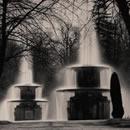 The fountains to be discussed in these sections are all lost to us now, and were never available to the public because they existed in the courtyards of private homes and villas. They are important though, because they still relate to Gian Lorenzo Bernini.
The fountains to be discussed in these sections are all lost to us now, and were never available to the public because they existed in the courtyards of private homes and villas. They are important though, because they still relate to Gian Lorenzo Bernini.
It was in 1648, that the Duke Giolamo Mattei viewed Barberini’s Triton water fountain, and that he decided he wanted Bernini to create a similar fountain for his villa at Caelian Hill, today called Celimontana. The only piece of evidence, an engraving by Venturini, Bernini placed a similar Triton at the end of one of the venues, though this one was livelier. It featured the triton sitting on three or four sea monsters that stretched out from the rocks that were half submerged in the low pool. The triton held their tails together, holding a conch shell up into the air, from which water fell.
The engraving shows two porters at the entrance, holding barrels with water trickling into small basins identical to the basins around the Triton Fountain. These are perhaps copied by Bernini from the work on the model in Via Lata.
A second fountain, also in the villa Mattei and built in 1648, was called Olympia. We know this from another engraving that was done by Venturini, as well as a description written by Baldinucci, who stated, "In another fountain made for Duke Girolamo Mattei's famous villa near the Navicella in Rome he wanted to do something grand and majestic, but the water would not rise very far. So he made an imaginary Mount Olympus, with an eagle flying over the top, a clever reference to the Mattei coat-of-arms. He used the mountain to portray the clouds which, unable to reach the summit of Olympus, sent down rain from where they were."
The inspiration for this fountain obviously came from the Eagles Fountain in the Vatican, with embellishments by Bernini. He embellished with what has become his typical “go-to” look, features three huge dolphins, in a row, that use their tails to hold up the opened shell, where the eagle is drinking.
The third fountain that demonstrated how Bernini’s fountains were recreations of other peoples designs comes from one he carved in 1653 and 1671. Bernini crafted this for Cardinal Anton Barberino near the Bastions. This fountain had very little water, but was able to create the finest of sprays. The figure is a women ringing out her hair after washing it, and that is what makes up the water feature. Bernini models this fountain of “Venus Washing her Hair” by Jean de Boulogne, and “Woman washing young boys hair”, by Valerio Cioli in Boboli.
One of the last of the modest courtyard fountains built by Bernini that is full of lively monotony. The repetitions of his favorite themes are portrayed in this fountain: the two bad-tempered tritons breathlessly blowing water from their conches and two dolphins with their tails in the air holding up the usual open shell.
This fountain now resembles a well that has been totally abandoned, but once sat beautifully backing into the boundary wall of a narrow courtyard garden. It had been built for a man named Paolo Strada, for his estate on the road that Paul V opened at the base of the Quirinale Hill. The house is number 15 on Via della Panetteria today!
Mr. Strada, a private servant to Clement IX, since he was Cardinal Rospigliosi, who received water grants as a reward for his faithful and outstanding services. A manuscript which was written from the Pope, he granted Strada three ounces from the aqua Felice in 1667, and them two more in 1669. Both times, Bernini was called to make the water features, creating modest fountains. These can be seen through his very own sketch, as well as an engraving by Venturini. The fountains were decorated with the Rospigliosi family crest, and later adapted to the arms of the Counts of Antamoro, who purchased the site in the 18th century.
